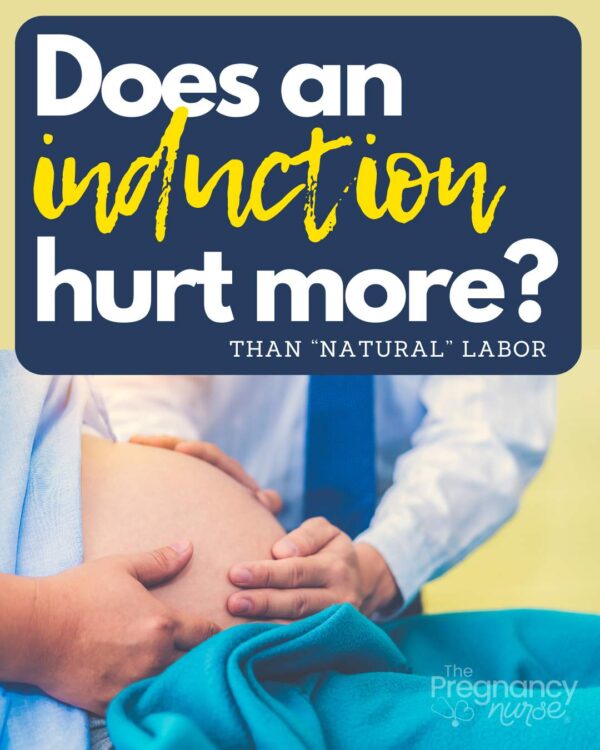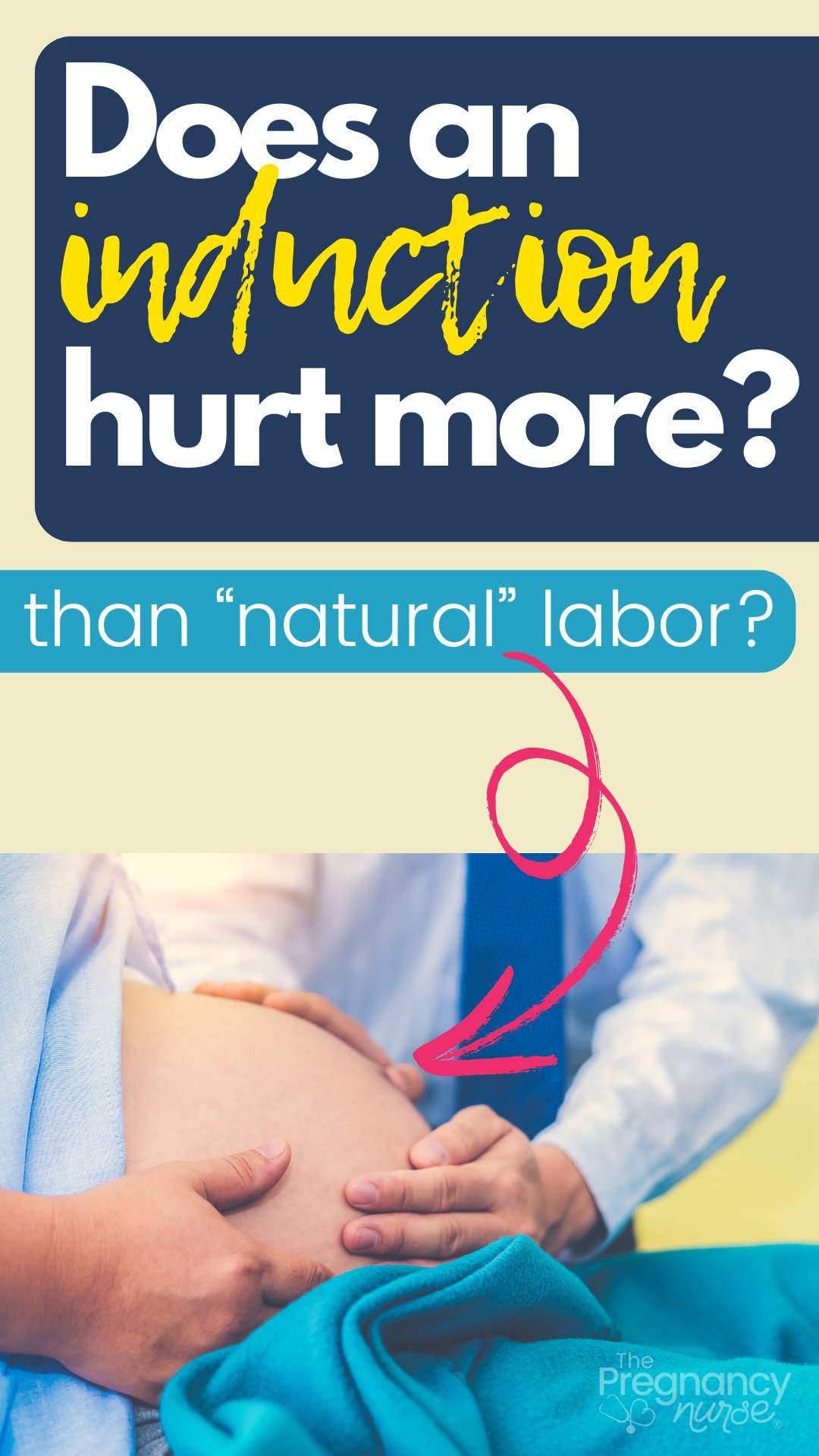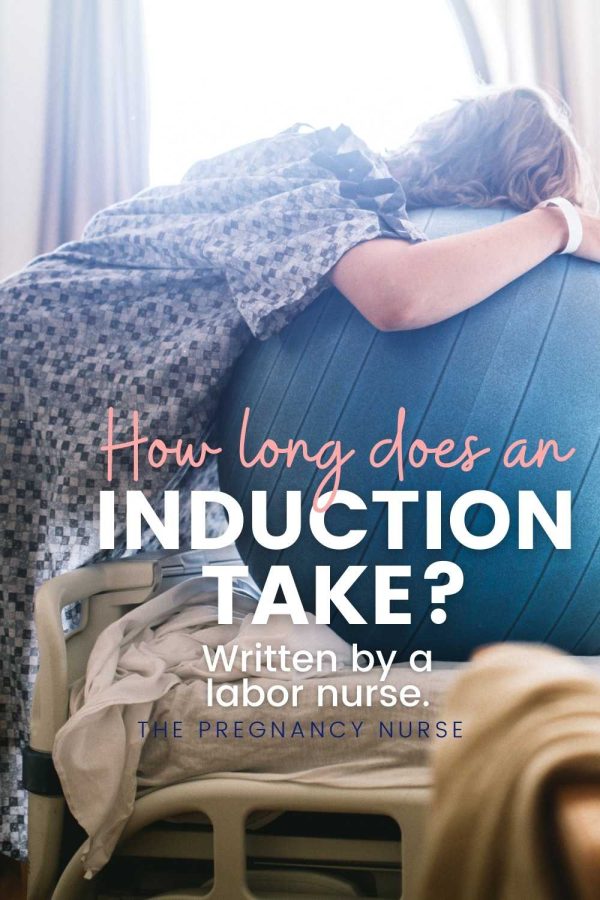If you’re considering an induction, you may wonder if it’s more painful than “regular” labor (meaning labor that comes on naturally). Today we’re going to look at some of of the “why’s” this might be that way, along with what studies show. Plus, my own experience with going both induced labor and “natural” labor with my own pregnancies. Let’s dive in!

Before we get started, if you’re considering an induction, you 100% want to grab my induction checklist to really have a discussion with your provider about what to expect, should you have one:
I also have a video on this exact same topic in case you’d like to listen:
Is an Induction More Painful?
If you look this up online you’ll see almost every single website saying that an induction is much more painful. While the studies may not back this up (more on that, keep reading) — there are a few reasons this could be true:
The Blood Brain Barrier
So, in the hospital we often give you Pitocin, which is the exact same chemical make-up as Oxytocin — meaning your body can’t tell them apart. So, it never made sense to me that the contractions would be more painful one way or another.
BUT, I then learned that Oxytocin is made by your brain (in your hypothalamus). Which means it bathes your brain at the same time through your blood supply around it. Oxytocin has a calming loving feeling to it (think attachment to a partner, or a baby). Your body gets that nice bonus as it makes Oxytocin.
Pitocin, is run in through an IV and will not cross the blood-brain barrier. Meaning your brain never gets the happy Oxytocin feelings along with the contractions.
Just the contractions.
I am not exactly sure how much this matters later in labor, but I do think it matters more in early labor when the oxytocin amounts are small and you’re not in as much pain.
Just know there’s some happiness that comes with Oxytocin, and you won’t get that Pitocin.
Want to know more about inductions — check out these posts:
- Pitocin to Induce Labor
- Inducing Labor at 39 Weeks: Pros and Cons
- 5 Reasons to NOT Get Induced
- What to Expect at A Foley Bulb Induction
- What Happens if Your Induction Doesn’t Work?
Fast Start/Slow Ramp-Up
While the hospital does start Pitocin as slow as they can (it’s about 1 drop in 30 minutes) they do ramp it up faster than it would normally ramp up inside your body.
Plus, we double it in that first half an hour. Usually going from 1 to 2 mu/min or 2 to 4 mu/min — which is a lot.
Fun facts: You can control your oxytocin drip. You can tell them to start it at one, and then increase just one milliunit per minute each time they increase it. Nurses don’t always ask, but it’s something you can state right at the very front. I think it helps when you say you react strongly to medications, and you’d like to start slow and have them ask before they increase it.
At home you tend to have a “I just feel gross” feeling for a while, and then slowly it progresses into contractions. But, you have to remember at home you’ve got your people, and your places you love to relax, the foods you like, but the hospital has…. (keep reading….)
Hospitals Suck
When you’re induced in the hospital the nurse is required to keep you on the monitor all the time.
This isn’t something you can refuse — because you’d also be refusing the induction medications.
Yes, you read that right — in order for your nurse to keep her license, if she is giving induction medication, she also has to have you on the monitor continuously.
While there have been some advances in how we monitor the heart rate and contractions. There are:
- Portable monitors
- Wireless monitors
- Waterproof monitors
And while all of those sound amazing… sometimes we can only get baby in one spot, sometimes wireless monitors won’t pick up, and sometimes the water hitting the waterproof monitors makes it impossible to use….
While technology can help us a lot, I hope you know it has lots of flaws…
It’s Not Home
You know that feeling when you get sick or don’t feel well and you just want to go home? You feel safe there, you have your best pillow and it just feels nice to be in your space.
Also, the hospital just isn’t as comfortable as home. It doesn’t have as many distractions as home and I feel like that ultimately just makes it much more uncomfortable.
Does this mean I’m pro-home birth? No. But I get it, I do.

What do studies show?
No one likes it when I bring this up — but in the Arrive Trial — where they studied if 39 week inductions were safer than “expectant management” where they just watch you to see if there’s a reason to induce otherwise you go into labor on your own.
They did ask people to rate their pain. Those who were induced, vs those who went into natural labor. The people in the induced group reported less pain and more control during their induction, than those who went into natural labor.
Now, you can decide what you want about all of that — but I think it’s solid evidence that some of this may well be in our minds (aka — you think it’s going to be worse, and the it is) vs reality.
Length of Time
The reality is that induction takes longer than natural labor — most of the time.
I think that a lot of it is due to us skipping that whole “I’m miserable…. oh wait, is this labor?” part.
Often we call that “generalized malaise” during that timeframe. You just don’t feel great — but in reality that’s getting your cervix ready for those harder contractions.
In the hospital that might be similar to the time that we’re using something like Cytotec or Cervidil — and you’re feeling contractions while laying in the bed, and there’s nothing to distract you like folding baby clothes, making some brownies, cleaning your house, taking a nap in your own bed, or laying on the couch with a heating pad.
The Arrive trial did show the length of labor, in general, was longer in those who were induced. I actually made a deep dive of the study in here to help you decide if an elective induction was right for you.
The length of time of an induction is probably the #1 thing that catches couples off-guard with an induction. That’s part of my induction checklist that I 100% recommend you review with your provider before planning an induction:
I did just write a post on a few things you can be doing in your last few weeks to make your cervix more favorable:
Patient Experiences show…?
Ok, I agree that data can only show us so much, but what do to real people say?
I’d say that about 70% say that it is more painful than “natural” labor.
However, there’s 30% who say it’s awfully similar — and I have to say that I’m in that camp. I had entirely natural labor on my first baby, I went into labor on my own on my 2nd but then was augmented once I got to the hospital, and then on my 3rd I went in for an induction. You can read more about my own induction here.
I felt like it was very similar to natural labor. But I was bored, and stuck in a miserable bed. Not fun, not fun at all.
But frankly, “natural” labor wasn’t that fun either!
The reality is that most people just prepare some breathing for birth and maybe learn the stages of labor, and how to change a diaper and then feel like they’re prepped for birth.
However, studies show that type of education falls short of what you actually need to know about birth.
In fact, most birth classes don’t even cover inductions, even though LOTS of people will need one. Nor do they really share what you need to know about a cesarean.
I’ve even found that many glaze over postpartum life and don’t really give you the tools and resources you need to sail through that phase a bit better.
I know my own birth class with my first baby didn’t prepare me at all for my forceps delivery which ultimately made me tear (a lot) and my postpartum anxiety had me in a grip I wasn’t ready for at all (and had no tools to help myself). I’m so glad that there is this now to make it so much easier to get prepared!
I recommend starting it ASAP — I think you’re going to get a lot out of it and really feel so much better about your upcoming birth!
SO, what do YOU think? Are inductions more painful? Tell us in the comments. I bet people would love to hear from other people what they thought!








 Do You Need a Birth Class if You Plan to Get an Epidural
Do You Need a Birth Class if You Plan to Get an Epidural
